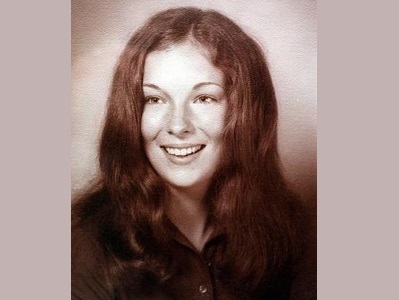
The victim, Lindy Sue Biechler. Credit: Lancaster County DA
David Sinopoli was never considered a suspect in the murder of 19-year-old Lindy Sue Biechler in 1975. In fact, despite clearing dozens of people over the nearly 50-year investigation, Sinopoli was never even on the radar of the Lancaster County (Pennsylvania) investigators.
That is until his ancestral ties to a small town in southern Italy combined with months of research using historical records, geographic and immigration patterns, birth records, descendancy searching and more gave him away—that and a discarded coffee cup at the Philadelphia International Airport.
Sinopoli was arrested at his home on July 17 and remanded to Lancaster County Prison without bail, according to the Lancaster County District Attorney’s Office.
The murder
On Dec. 5, 1975, the newly married Biechler returned home from the grocery store around 7 p.m. Before she could even begin to put the groceries away, she was attacked with a knife from her own kitchen. She was sexually assaulted, and sustained 19 stab wounds to her neck, chest, upper abdomen and back.
When investigators were called to the apartment not even two hours later, they observed signs of a struggle and found Biechler lying on her back with a knife sticking out of her neck. A towel wrapped around the wooden handle negated the possibility of prints.
Biechler’s cause of death was determined to be massive bleeding due to multiple stab wounds. Despite an in-depth investigation into the homicide and multiple leads over the years, the case went cold.
Advancing technology: DNA, genealogy, DNA again and blood
But Lancaster County investigators did not give up. They took advantage of advancing forensic technology whenever they could. This results in a major case update in 1997, when investigators submitted Biechler’s underwear to a crime lab for DNA analysis. The lab was able to obtain a male DNA profile, which was uploaded into CODIS three years later. However, no match was found.
The next case break came in 2019 when the newly formed Lancaster County District Attorney’s Cold Case unit enlisted the help of Parabon NanoLabs. Using its Snapshot phenotype service, Parabon concluded the suspect was fair-skinned, had hazel eyes, had dark hair and no freckles.
With that information in hand, chief genetic genealogist CeCe Moore began her research—but this case was unlike others. There were no genealogically promising individual matches to the suspect’s DNA. The matches were incredibly distant at 30 centimorgans and below.
“For that reason, I had to pursue a novel, non-traditional strategy as a possible alternate avenue,” Moore explained during a press conference. “This approach relies on a survey of geographic and immigration patterns, as well as associated surnames. It necessitated that the subject had deep roots in the local Lancaster community.”
Moore’s family tree research revealed that the people sharing DNA with the unknown suspect were immigrant families from Catanzaro, a province in southern Italy. Historical records showed the majority of Italian immigrants in Lancaster were from a small town named Gasperina, which is in Catanzaro.
Local records were thoroughly searched for those who listed their birthplace as, Italy. From there, a list was compiled that Moore used to do a descendancy research to identify male descendants who were of the appropriate age to be a possible suspect.
Moore said match data and the Snapshot indicated the suspect had 100% Italian ancestry with all roots originating in Gasperina. That information combined with the small number of individuals living in Lancaster at the time of the crime that were the right age and gender helped Moore narrow down the pool.
After months, Moore identified Sinopoli as a compelling candidate, and turned his name over to investigators.
“Investigative genetic genealogy like this should be treated only as a lead generator, like a tip,” Moore said of the unusual approach she had to take in this case. “It’s a highly scientific tip, but a tip just the same.”
Detectives used the tip to surveil Sinopoli until they were able to surreptitiously obtain his DNA in February 2022 from a discarded coffee cup he threw into a trash can before boarding a flight at the Philadelphia International Airport.
The coffee cup was then submitted to DNA Labs International for testing and in April, it was determined the DNA on the cup contained a mixture with one male contributor. The mixture data was sent to Cybergenetics, the company behind TrueAllele. Mark Perlin and his team compared that mixture to the DNA DNA identified in the semen left on Biechler’s underwear.
“Our software unmixed the two items, and found a match between them—ten trillion times more probable than coincidence," Perlin told Forensic.
As a last investigative step, Lancaster detectives consulted with a blood spatter expert to determine if any blood on Biechler’s clothing would be consistent with having been left by the suspect. The expert identified two blood spots on the exposed part of the victim’s pantyhose, which were then sent to DNA Labs International. In June, the blood drops were also determined to be consistent with the DNA profile obtained from Biechler’s underwear.
Sinopoli was then arrested at his home on July 17.
“There has been a never-ending pursuit of justice in this case that has led us to identifying and arresting Sinopoli,” said Lancaster District Attorney Heather Adams. “Lindy Sue Biechler was on the minds of many throughout the years. Certainly, law enforcement never forgot about Lindy Sue, and this arrest marks the first step to obtaining justice for her and holding her killer responsible.”